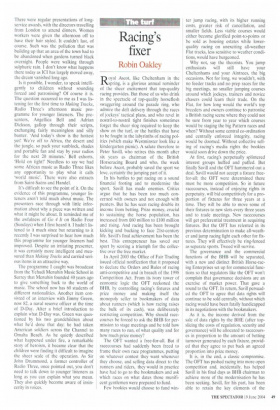Racing's fixer
Robin Oakley
Royal Ascot, like Cheltenham in the spring, is a glorious annual reminder of the sheer excitement that top-quality racing provides. But those of us who drink in the spectacle of top-quality horseflesh swaggering around the parade ring, who admire the deft delivery through the races of jockeys' tactical plans, and who revel in nostril-to-nostril tight finishes sometimes forget the sheer slog required to keep the show on the turf, or the battles that have to be fought in the labyrinths of racing politics (which make Westminster look like a kindergarten picnic). A salute therefore to Peter Savill, who retires this month after six years as chairman of the British Horseracing Board and who, the week before Ascot, probably saved the sport we love, certainly the jumping part of it.
In his battles to put racing on a sound financial footing and to modernise the sport. Savill has made enemies. Critics argue that he has been too much concerned with owners and not enough with punters. But he has seen racing double its income from betting. Prize money, crucial to sustaining the horse population, has increased from £60 million to £100 million and rising. And racing has been brought kicking and bucking to face 21st-century life. Savill's final achievement has been the best. This entrepreneur has saved our sport by scoring a triumph for the collective over the free market.
In April 2003 the Office of Fair Trading issued official notification that it proposed to declare the Orders and Rules of racing anti-competitive and in breach of the 1998 Competition Act. From its ivory tower of economic logic the OFT reckoned the BHB, by controlling racing's fixtures and prize money and making itself the monopoly seller to bookmakers of data about runners (which is how racing raises the bulk of its cash), was deliberately restricting competition. Why should racecourses be forced to ask the BHB for permission to stage meetings and be told how many races to run, of what quality and for how much prize money?
The OFT wanted a free-for-all. But if racecourses had suddenly been freed to frame their own race programmes, putting on whatever contest they want whenever they choose, and selling data direct to the runners and riders, they would in practice have had to go to the bookmakers and ask which races on what dates those munificent gentlemen were prepared to fund.
Few bookies would choose to fund win
ter jump racing, with its higher running costs, greater risk of cancellation, and smaller fields. Less viable courses would either become glorified point-to-points or be sold as housing estates while lowerquality racing on unexciting all-weather Flat tracks, less sensitive to weather conditions, would have burgeoned.
Why not, say the theorists. You jump enthusiasts will still have your Cheltenhams and your Aintrees, the big occasions. Not for long, we wouldn't, with no feeder tracks and no prep races for the big meetings, no smaller jumping courses around which jockeys, trainers and novice chasers could learn their trade. On the Flat, for how long would the world's top breeders and owners continue to patronise a British racing scene where they could not be sure from year to year which courses would be staging the big Pattern races and when? Without some central co-ordination and centrally enforced integrity, racing would be doomed. Without collective selling of racing's media rights the bookies would soon drive down the price.
At first, racing's perpetually splintered interest groups huffed and puffed. But finally Savill and the OFT hammered out a deal. Savill would not accept a fixture freefor-all: the OFT were determined there must be more competition. So in future racecourses, instead of enjoying rights in perpetuity, will bid competitively for a proportion of fixtures for three years at a time. They will be able to move some of their fixtures to new slots every three years and to trade meetings. New racecourses will get preferential treatment in acquiring fixtures. But the OFT has relented in its previous determination to make all-weather and jump racing fight each other for fixtures. They will effectively be ring-fenced as separate sports. Tweed will survive.
The governance and the commercial functions of the BHB will be separated, with a new and distinct British Horse-racing Enterprises set up for commercial functions so that regulators like the OFT won't complain that governance decisions are an exercise of market power. That gave a round to the OFT. In return, Savill persuaded the OFT to agree that data rights will continue to be sold centrally, without which racing would have been fatally handicapped in its negotiations with the bookmakers.
As it is, the income derived from the sale of data rights by the BHE (after topslicing the costs of regulation, security and governance) will be allocated to racecourses in proportion to the amount of betting turnover generated by each fixture, provided that they agree to put back an agreed proportion into prize money.
It is, in the end, a classic compromise. The OFT has pushed racing into more open competition and, incidentally, has helped Savill in his final days as BHB chairman to achieve more of the modernisation he has been seeking. Savill, for his part, has been able to retain the key elements of the sport's central structure and to save jump racing for a few more generations. The BHB chairman's name was unaccountably missing from the Queen's Birthday Honours list. Racing fan that she is, she should have made up for that by calling him down in front of the grandstand and dubbing him Sir Peter on the spot.



































































 Previous page
Previous page